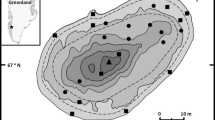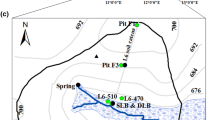Abstract
Increasing global temperatures are changing the balance between carbon sequestration and its microbial processing in wetlands, making the tracking of these processes important. We used detrital carbon stable isotopes (δ13C) to trace aerobic decomposition and CH4 production in two experiments conducted in Alaskan wetlands. In laboratory bottle incubations, larger decreases in detritus δ13C corresponded to higher net CH4 and CO2 production rates. Because net CH4 production was the stronger predictor and its effect was negative, we hypothesize that decreases in δ13C trace concurrent CH4 production and oxidation. In a field experiment, decreases in detritus δ13C were not correlated with aerobic decomposition rates, but were positively correlated with CH4 production potentials as estimated from bottle incubations. We hypothesize that the positive relationship reflects only CH4 production, rather than concurrent production and oxidation. Although CH4 production rates were correlated with changes in detrital δ13C in both experiments, the direction of this relationship differed between laboratory and field with important consequences for the scale of ecological experiments. Our study demonstrates that CH4 cycling can create distinct patterns in δ13C of wetland detritus. Future studies should conduct explicit mass balance experiments to clarify mechanisms and determine the importance of scale in shaping isotopic patterns.





Similar content being viewed by others
References
Bastviken D, Ejlertsson J, Sundh I, Tranvik L (2003) Methane as a source of carbon and energy for lake pelagic food webs. Ecology 84:969–981
Bastviken D, Cole J, Pace M, Tranvik L (2004) Methane emissions from lakes: dependence of lake characteristics, two regional assessments, and a global estimate Global Biogeochemical Cycles 18:12
Bastviken D, Cole J, Pace M, Van de Bogert M (2008) Fates of methane from different lake habitats: connecting whole-lake budgets and CH4 emissions. J Geophys Res 113:1–13
Benner R, Fogel ML, Sprague EK, Hodson RE (1987) Depletion of 13C in lignin and its implications for stable carbon isotope studies. Nature 329:708–710
Bridgham SD, Megonigal JP, Keller JK, Bliss NB, Trettin C (2006) The carbon balance of north American wetlands. Wetlands 26:889–916
Bridgham SD, Cadillo-Quiroz J, Keller JK, Zhuang Q (2013) Methane emissions from wetlands: biogeochemical, microbial, and modeling perspectives from local to global scales. Glob Chang Biol 19:1325–1346
Bryant MD (1991) The Copper River delta pulse study: an interdisciplinary survey of the aquatic habitats. General Technical Report PNW–GTR–282
Bunn SE, Boon PI (1993) What sources of organic carbon drive food webs in billabongs? A study based on stable isotope analysis. Oecologia 96:85–94
Burnham KP, Anderson DR (2002) Model selection and multi-model inference: a practical information-theoretic approach, 2nd edn. Springer-Verlag, Inc., New York
Carpenter SR, Chisholm SW, Krebs CJ, Schindler DW, Wright RF (1995) Ecosystem experiments. Science New Series 269:324–327
Conrad R (2005) Quantification of methanogenic pathways using stable carbon isotopic signatures: a review and a proposal. Organic Geochemistry 36:739–752
Corbett JE, Tfaily MM, Burdige DJ, Cooper WT, Glaser PH, Chanton JP (2013) Partitioning pathways of CO2 production in peatlands with stable carbon isotopes. Biogeochemistry 114:327–340
Dai J, Sun MY, Culp RA, Noakes JE (2005) Changes in chemical and isotopic signatures of plant materials during degradation: implication for assessing various organic inputs in estuarine systems. Geophysical Research Letters 32:1–4
DelVecchia AG, Stanford JA, Xu X (2016) Ancient and methane-derived carbon subsidizes contemporary food webs. Nature Communications 7:1–9
Eller G, Deines P, Grey J, Richnow HH, Kruger M (2005) Methane cycling in lake sediments and its influence on chironomid larval δ13C. FEMS Microbiology Ecology 54:339–350
Fellerhoff C, Voss M, Wantzen KM (2003) Stable carbon and nitrogen isotope signatures of decomposing tropical macrophytes. Aquatic Ecology 37:361–375
Gannes LZ, O’Brien DM, Martínez del Rio C (1997) Stable isotopes in animal ecology: assumptions, caveats, and a call for more laboratory experiments. Ecology 78:1271–1276
Grey J (2016) The incredible lightness of being methane-fueled: stable isotopes reveal alternative energy pathways in aquatic ecosystems and beyond. Frontiers in Ecology and Evolution 4:8
Grey J, Kelly A, Jones RI (2004) High intraspecific variability in carbon and nitrogen stable isotope ratios of lake chironomid larvae. Limnology and Oceanography 49:239–244
Hamilton SK, Lewis WM Jr, Sippel SJ (1992) Energy sources for aquatic animals in the Orinoco River floodplain: evidence from stable isotopes. Oecologia 89:324–330
Hershey AE, Northington RM, Hart-Smith J, Bostick M, Whalen SC (2015) Methane efflux and oxidation, and use of methane-derived carbon by larval chironomini, in arctic lake sediments. Limnology and Oceanography 60:276–285
Jones RI, Carter CE, Kelly A, Ward S, Kelly DJ, Grey J (2008) Widespread contribution of methane-cycle bacteria to the diets of lake profundal chironomid larvae. Ecology 89:857–864
Junk WJ, Brown M, Campbell IC, Finlayson M, Gopal B, Ramberg L, Warner BG (2006) The comparative biodiversity of seven globally important wetlands: a synthesis. Aquatic Sciences 68:400–414
Kirschke S, Bousquet P, Ciais P, Saunois M, Canadell JG, Dlugokencky EJ et al (2013) Three decades of global methane sources and sinks. Nature Geoscience 6:813–823
Kohzu A, Kato C, Iwata T, Kishi D, Murakami M, Nakano S, Wada E (2004) Stream food web fueled by methane-derived carbon. Aquat Microb Ecol 36:189–194
Kwak TJ, Zedler JB (1997) Food web analysis of southern California coastal wetlands using multiple stable isotopes. Oecologia 110:262–277
Lehmann MF, Bernasconi SM, Barbieri AL, McKenzie JA (2002) Preservation of organic matter and alteration of its carbon and nitrogen isotope composition during simulated and in situ early sedimentary diagenesis. Geochimica et Cosmochimica Acta 66:3573–3584
Matthews HD (2007) Implications for CO2 fertilization for future climate change in a coupled climate-carbon model. Global Change Biology 13:1068–1078
Melton JR, Wania R, Hodson EL, Poulter B, Ringeval B, Spahni R et al (2013) Present state of global wetland extent and wetland methane modelling: conclusions from a model inter-comparison project (WETCHIMP). Biogeosciences 10:753–788
Myhre G, Shindell D, Breon FM, Collins W, Fuglestvedt J, Huang J et al (2013) Anthropogenic and natural radiative forcing. In: Climate change 2013: the physical science basis. Contribution of working group I to the fifth assessment report of the Intergovernmental Panel on Climate Change. Cambridge University Press, Cambridge and New York
Peterson BJ (1999) Stable isotopes as tracers of organic matter input and transfer in benthic food webs: a review. Acta Oecologica 20:479–487
R Core Development Team (2015) R: a language and environment for statistical computing. R Foundation for Statistical Computing, Vienna, Austria. https://www.R-project.org/
Ringeval B, Friedlingstein P, Koven C, Ciais P, de Noblet-Ducoudre N, Decharme B, Cadule P (2011) Climate-CH4 feedback from wetlands and its interaction with the climate-CO2 feedback. Biogeosciences 8:2137–2157
Rossi L, Costantini ML, Carlino P, di Lascio A, Rossi D (2010) Autochthonous and allochthonous plant contributions to coastal benthic detritus deposits: a dual-stable isotope study in a volcanic lake. Aquatic Sciences 72:227–236
Schindler DW (1998) Whole-ecosystem experiments: the need for ecosystem-scale experiments. Ecosystems 1:322–334
Sierszen ME, Morrice JA, Moffett MF, West CW (2004) Benthic versus planktonic foundations of three Lake Superior coastal wetland food webs. Journal of Great Lakes Research 30:31–43
Sierszen ME, Morrice JA, Trebitz AS, Hoffman JC (2012) A review of selected ecosystem services provided by coastal wetlands of the Laurentian Great Lakes. Aquatic Ecosystem Health and Management 15:92–106
Thilenius JF (1990) Woody plant succession on earthquake-uplifted coastal wetlands of the Copper River delta, Alaska. Forest Ecology and Management 33(34):439–462
Tiegs SD, Clapcott JE, Griffiths NA, Boulton AJ (2013) A standardized cotton-strip assay for measuring organic-matter decomposition in streams. Ecological Indicators 32:131–139
Troxler TG, Richards JH (2009) δ13C, δ15N, carbon, nitrogen and phosphorus as indicators of plant ecophysiology and organic matter pathways in Everglades deep slough, Florida, USA. Aquatic Botany 91:157–165
Vander Zanden MJ, Rasmussen JB (1999) Primary consumer δ13C and δ15N and the trophic position of aquatic consumers. Ecology 80:1395–1404
Vizza C, Zwart JA, Jones SE, Tiegs SD, Lamberti GA (2017a) Landscape patterns shape wetland pond ecosystem function from glacial headwaters to ocean. Limnology and Oceanography 62:S207–S221
Vizza C, West WE, Jones SE, Hart JA, Lamberti GA (2017b) Regulators of coastal wetland methane production and responses to simulated global change. Biogeosciences 14:431–446
Vizza C, Hart JA, West WE, Jones SE, Lamberti GA (in review) Balancing CH4 budgets in Alaskan ponds: ebullition integrates alternate sources of CH4 production
Walther GR, Post E, Convey P, Menzel A, Parmesan C, Beebee TJC et al (2002) Ecological responses to recent climate change. Nature 416:389–395
Wedin DA, Tieszen LL, Dewey B, Pastor J (1995) Carbon isotope dynamics during grass decomposition and soil organic matter formation. Ecology 76:1383–1392
West WE, Coloso JJ, Jones SE (2012) Effects of algal and terrestrial carbon on methane production rates and methanogen community structure in a temperate lake sediment. Freshwater Biology 57:949–955
West WE, Creamer KP, Jones SE (2016) Productivity and depth regulate lake contributions to atmospheric methane. Limnology and Oceanography 41:1–11
Whalen SC (2005) Biogeochemistry of methane exchange between natural wetlands and the atmosphere. Environmental Engineering Science 22:73–94
Whiting GJ, Chanton JP (2001) Greenhouse carbon balance of wetlands: methane emission versus carbon sequestration. Tellus 53B:521–528
Wuebbles DJ, Hayhoe K (2002) Atmospheric methane and global change. Earth-Science Reviews 57:177–210
Zar JH (2010) Biostatistical analysis, 5th edition. Pearson, Upper Saddle Rivers, USA
Acknowledgements
We thank the Cordova Ranger District of the USDA Forest Service for providing instrumental field and logistical support. In particular, we thank Deyna Kuntzsch, Andrew Morin, Sean Meade, Luca Adelfio, and Ken Hodges for making fieldwork on the Copper River Delta possible. The UND Center for Environmental Science and Technology provided instrumentation and analytical assistance for chemical and stable isotope analysis. The UND Environmental Research Center provided instrumentation for gas chromatography. We would like to acknowledge Mike Brueseke for laboratory support. This study was made possible by the UND College of Science Summer Undergraduate Research Fellowship awarded to J.A. Hart and by a National Science Foundation Graduate Research Fellowship awarded to C. Vizza. Additional funding and support was provided by the University of Notre Dame College of Science and the USDA Forest Service Pacific Northwest Research Station.
Author information
Authors and Affiliations
Corresponding authors
Ethics declarations
Conflict of Interest Statement
The authors declare that they have no conflicts of interest.
Rights and permissions
About this article
Cite this article
Hart, J.A., Vizza, C., West, W.E. et al. Methane Cycling Contributes to Distinct Patterns in Carbon Stable Isotopes of Wetland Detritus. Wetlands 39, 361–370 (2019). https://doi.org/10.1007/s13157-018-1119-1
Received:
Accepted:
Published:
Issue Date:
DOI: https://doi.org/10.1007/s13157-018-1119-1




